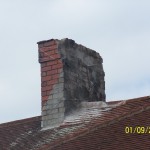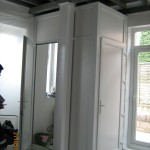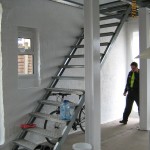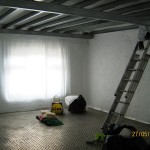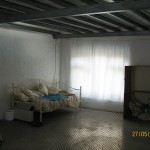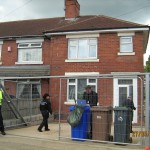A home owner has been banned from living in his own house after carrying out a range of potentially dangerous and illegal DIY alterations. (PDF of House Photos Below)
 |
| [relatedPosts title=”Related Posts”] |
|
|
In August 2011, Stoke-on-Trent City Council successfully prosecuted the man for not complying with an order stopping anyone from living in the semi-detached property. It followed a string of complaints from neighbours and detailed investigations by Council Environmental Health Officers which revealed that the house had:
- No heating throughout the property.
- No fixed lighting for the entire property.
- Internal cavity wall insulation removed.
- No provision of a kitchen and no hot water for a kitchen, and no work surfaces or storage cupboards.
- Low headroom and not enough space to sleep in a converted loft, used as a bedroom.
- No fixed form of stairs to the loft, no handrail or guards on ground floor stairs.
- No hot water to the bathroom sink, and an open drain inside the back of the property.
- All electrical sockets for the entire property moved to one central downstairs location.
- An unsupported chimney, after the chimney breast column was removed.
Councillor Gwen Hassall, Cabinet member for Housing and Neighbourhoods, said: “The home owner had systematically carried out a range of changes to his property over a number of months. But the changes he made were staggering, and beggared belief.
“He had gutted every room in the property, stripped the walls back to bare brick, raised the height of the ground floor and first floor ceilings, and had been sleeping in a converted loft that was no bigger than three feet in height, because of his alterations.
“The changes created serious hazards, including excessive cold, food safety and personal hygiene hazards, and also damaged the adjoining semi-detached property. He had exposed so much of the ground flooring of the property that the damp proofing course had been removed. This means that ground water can come into the property and damp and mould can grow.
“Furthermore, all of the changes were carried out to the property without the necessary building regulations.
“Council officers have been working very closely with the home owner to help him improve the property in the interests of health and safety, and since then, work has been done. But officers had found that staircases had been rebuilt using wooden crates and fastened together with string, internal walls had been rebuilt, using 25mm insulation boards, and plastic coverings had been put across all the exposed brickwork and windows.”
Stoke-on-Trent City Council successfully took the home owner to court in August, where he was fined £910, and the council was awarded £622 in costs.
However, it has since emerged that the home owner is now renting out the house in Uplands Road, Abbey Hulton to a private tenant, after making further alterations to the property. This is despite being told by the Magistrates’ that the house is uninhabitable. The Council has a duty of care to assist the tenant, and has worked swiftly to identify suitable alternative accommodation.
Further Information
A pdf of the House Pictures can be found here.
Updated on 18-11-11 with further information from Neil Watson of Stoke-on-Trent City Council
Q: Was the Prohibition Order served while the property was owner occupied, or was it privately rented when served?
A: The Housing Act 2004 section 20 and 21 Prohibition Order was served on the then owner occupier, after carrying out a massive amount of alterations to a previous right to buy mid 1950 council house.
- Some of the alterations included removal of all integral compartmentalising walls the suspended timber floors, all ceilings and stairs. The reinstated stairs were very steep with no hand rails or guarding while floors and ceilings were replaced with steel columns, beams and topped with 5mm steel checker plate floors. The entire ground level was reduced internally by some 450mm and breaching the dpm and well below the dpc.
- The kitchen, bathroom inner leaf of brick work and chimney breasts were all removed as was the entire electrical installation and replaced with 12 single power sockets all located on a single board some 2.5 meters off the ground floor. I could go on.
Q: It appears the owner was prosecuted for failing to comply with a Prohibition Order, is that the case?
A: The owner occupier was prosecuted as a result of his continued residence at the property.
Q: Could you clarify the section of the Housing Act under which the offence occurred?
A: A successful prosecution was brought against the owner (in August 2011) for the Housing act 2004 section 32 offence of allowing the occupation of a property while knowing that a prohibition order was in place.
We also successfully prosecuted for the Housing Act 2004 s236 offence of failing to provide documentation required of him. At the time of the prosecution the owner occupier has made many amendments to the property from the initial items included on the schedules attached to the Prohibition Order, however none of these subsequent alterations were carried out to my standards nor were they carried out in a workmanship manner or to level which significantly reduced the hazards to an acceptable level.
Subsequently the owner did rent the property out to a private tenant (this tenant has now been rehoused) and the landlord has now moved back into the property become the owner occupier again!
I am currently compiling another prosecution case for the Housing act 2004 section 32 offence for the daily fine not exceeding £20.00 for every day he has used or allowed the property to be used since his previous conviction.
Q: And finally, I have been asked if you have any more photos.
A: Yes I have photos at numerous stages of alterations.
- Click to enlarge
- Click to enlarge
- Click to enlarge
- Click to enlarge
- Click to enlarge
- Click to enlarge


